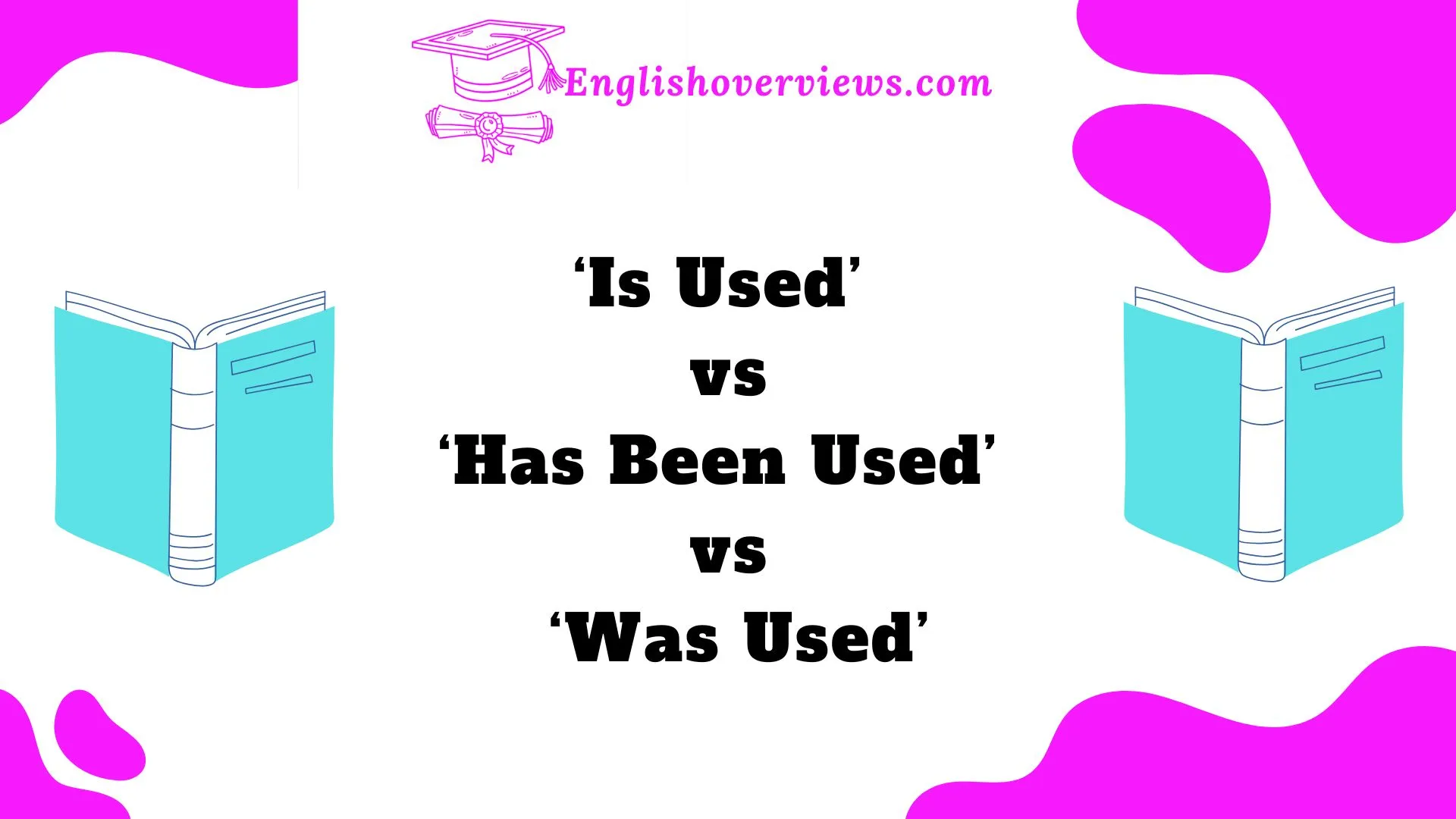Understanding English verb tenses can sometimes feel like solving a puzzle. When to use “is used,” “has been used,” and “was used” can trip up even the most seasoned writers and speakers. Each of these phrases carries its own unique meaning, which is why it’s crucial to understand when to use them correctly.
In this comprehensive guide, we’ll break down the differences between these three verb forms and provide you with real-world examples, tips, and tricks to master them.
By the end of this post, you’ll be able to confidently choose the correct verb tense, improving both your writing and speaking skills.
Whether you’re crafting an email, preparing a presentation, or just having a conversation, knowing the right tense is key to clear communication. Let’s dive in!
The Role of Verb Tenses in English Grammar
Verb tenses are the backbone of English grammar. They show when an action happens—whether in the past, present, or future. In simple terms, verb tenses tell us when something occurred and whether it’s still relevant.
Verb tenses can get tricky because they don’t just communicate time—they also indicate the state of completion (whether the action is finished or ongoing). Let’s look at a few examples:
- Present Tense: “She reads every day.”
- Past Tense: “She read yesterday.”
- Future Tense: “She will read tomorrow.”
The three verb forms we’re focusing on—“is used,” “has been used,” and “was used”—are all ways to describe actions in the present or past, but each one tells a different story.
‘Is Used,’ ‘Has Been Used,’ and ‘Was Used’ – What’s the Difference?
Understanding when to use each of these verb forms is key to sounding fluent and natural. Here’s a quick reference table to summarize their meanings:
| Verb Form | Tense | When to Use | Example |
| Is Used | Present Simple | To describe regular actions or general truths in the present. | “This tool is used every day.” |
| Has Been Used | Present Perfect | To indicate an action started in the past and continues to the present. | “This method has been used for years.” |
| Was Used | Past Simple | To describe a completed action in the past. | “This machine was used yesterday.” |
When to Use ‘Was Used’ (Past Simple)
The verb form “was used” is in the past simple tense, which refers to an action that was completed in the past. It’s used when you want to describe something that happened at a specific time in the past.
Defining ‘Was Used’ in Past Tense Contexts
- Use this form when you’re talking about an event that’s already finished and no longer relevant to the present.
- It’s not about ongoing actions or things still happening, but about things that happened and were finished.
Examples of ‘Was Used’
- “The software was used during last year’s conference.”
- “This recipe was used at my grandmother’s house for decades.”
- “The equipment was used to conduct the experiments.”
Key Points to Remember
- “Was used” can describe past events with a clear time or date (even if it’s implied).
- It doesn’t connect to the present, so it’s often used for specific, completed actions.
Decoding ‘Has Been Used’ (Present Perfect)
The phrase “has been used” is in the present perfect tense, which connects past actions to the present. It shows that something started in the past but continues to be relevant today.
What is the Present Perfect Tense?
The present perfect tense is all about linking the past to the present. It’s used when the action:
- Happened in the past.
- Is still important or relevant in the present.
When to Use ‘Has Been Used’
You use “has been used” when you’re talking about something that was ongoing or relevant to the current situation.
Examples of ‘Has Been Used’
- “The technique has been used in many studies over the years.”
- “This method has been used for decades to improve productivity.”
- “The system has been used in multiple departments this year.”
Key Points to Remember
- “Has been used” is used when there’s a relevance to the present. It links the past action to the current context.
- It’s not about an event happening at a specific moment in time, but about a repeated or ongoing use.
Understanding ‘Is Used’ (Present Simple)
The phrase “is used” is in the present simple tense. This verb form is used to describe regular, habitual actions or to state general truths.
When to Use ‘Is Used’
You use “is used” when talking about something that is habitual or commonly done in the present.
Examples of ‘Is Used’
- “This tool is used every day by the workers.”
- “The formula is used in multiple scientific fields.”
- “This method is used to solve complex problems.”
Key Points to Remember
- “Is used” refers to actions that happen regularly, habitually, or universally.
- It’s perfect for general statements or facts about the present.
Common Mistakes and Misconceptions
Even experienced English users sometimes mix up these tenses. Here are some common mistakes to watch out for:
Mistake #1: Confusing ‘Was Used’ with ‘Has Been Used’
- Incorrect: “The method was used for years before we changed it.”
- Correct: “The method has been used for years before we changed it.”
Mistake #2: Using ‘Is Used’ for Past Actions
- Incorrect: “This technique is used for the project we completed last month.”
- Correct: “This technique was used for the project we completed last month.”
Mistake #3: Using ‘Has Been Used’ in the Past Tense
- Incorrect: “This system has been used yesterday.”
- Correct: “This system was used yesterday.”
Tips for Avoiding Mistakes
- Always check whether the action is connected to the present or if it’s a one-time event.
- Use “is used” for general truths or repeated actions in the present.
- Use “was used” for actions completed in the past with no link to the present.
- Use “has been used” when the action started in the past but still affects the present.
Tips for Choosing the Right Verb Tense
Choosing the correct verb tense isn’t always easy, but with these tips, you’ll feel more confident:
Tip #1: Consider the Timeline of the Action
Is the action happening in the past, present, or is it ongoing? This is the first step in deciding which verb form to use.
Tip #2: Determine Relevance to the Present
Does the action have continuing relevance to the present moment? If so, use “has been used.”
Tip #3: Think About Whether the Action is Habitual
For actions that happen regularly or as general truths, use “is used.”
Tip #4: Check the Specificity of the Action
For events that happened at a specific point in the past with no relevance to the present, go with “was used.”
The Impact of Correct Verb Tense on Clarity in Writing and Speaking
Using the correct verb tense doesn’t just make your grammar correct—it makes your communication clearer and more effective. Whether you’re writing an email, crafting a report, or speaking to someone, using the right tense:
- Clarifies your meaning: Listeners and readers won’t be confused about when something happened.
- Enhances readability: Correct tense use helps your writing flow better and makes it easier to understand.
- Improves professionalism: Using the right verb tense shows attention to detail and improves the overall tone of your communication.
FAQs
Q1: What’s the difference between ‘is used’ and ‘was used’?
A1: “Is used” is for things that happen regularly in the present, while “was used” describes something that happened and was completed in the past.
Q2: Can I use ‘has been used’ for past actions?
A2: No. “Has been used” links the past action to the present. For past events without present relevance, use “was used.”
Q3: When should I use the present perfect tense (‘has been used’)?
A3: Use “has been used” when talking about an action that started in the past but has relevance to the present moment, such as a habit or ongoing effect.
Q4: Can these verb forms be used interchangeably?
A4: No. Each verb tense has a specific role. Use them correctly to ensure clarity.
Conclusion
Mastering verb tenses like “is used,” “has been used,” and “was used” is essential for clear communication in English. By understanding the differences between these verb forms, you can significantly improve your writing and speaking.
Remember to think about timing, relevance, and specificity when choosing which verb tense to use. Keep practicing, and soon, these verb forms will feel second nature.

Alyan Ashraf is the creative mind behind English Overviews, a platform dedicated to helping learners master the English language. Passionate about education and language development, Alyan specializes in simplifying complex English concepts, making learning accessible for students of all levels.











